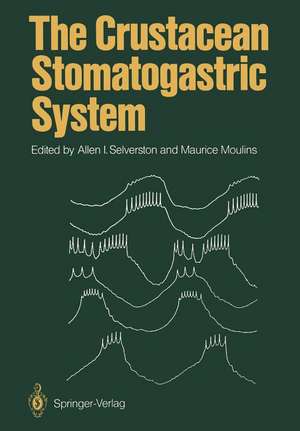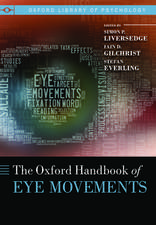The Crustacean Stomatogastric System: A Model for the Study of Central Nervous Systems
Editat de Allen I. Selverston, Maurice Moulinsen Limba Engleză Paperback – 10 dec 2011
Preț: 646.11 lei
Preț vechi: 760.13 lei
-15% Nou
Puncte Express: 969
Preț estimativ în valută:
123.64€ • 132.21$ • 103.08£
123.64€ • 132.21$ • 103.08£
Carte tipărită la comandă
Livrare economică 18 aprilie-02 mai
Preluare comenzi: 021 569.72.76
Specificații
ISBN-13: 9783642715181
ISBN-10: 3642715184
Pagini: 360
Ilustrații: XVI, 338 p.
Dimensiuni: 170 x 244 x 19 mm
Greutate: 0.58 kg
Ediția:Softcover reprint of the original 1st ed. 1987
Editura: Springer Berlin, Heidelberg
Colecția Springer
Locul publicării:Berlin, Heidelberg, Germany
ISBN-10: 3642715184
Pagini: 360
Ilustrații: XVI, 338 p.
Dimensiuni: 170 x 244 x 19 mm
Greutate: 0.58 kg
Ediția:Softcover reprint of the original 1st ed. 1987
Editura: Springer Berlin, Heidelberg
Colecția Springer
Locul publicării:Berlin, Heidelberg, Germany
Public țintă
ResearchCuprins
1 Functional Anatomy and Behavior.- 1.1 Functional Anatomy.- 1.2 Behavior.- 2 Neuromuscular Organization and Pharmacology.- 2.1 Neuromuscular Organization.- 2.2 Neuromuscular Pharmacology.- 2.3 Conclusion.- Appendix: Conditional Regenerative Properties in the Pyloric Dilator Muscle: Their Functional Implications.- 3 Neural Circuits.- 3.1 Circuits of the Stomatogastric Ganglion.- 3.2 COG Neurons and the STG Circuits.- 3.3 Descending Inputs to the STG Circuits.- 3.4 Other Stomatogastric Circuits.- 3.5 Evidence for Monosynaptic Nature of STG Synapses.- 3.6 Significance of Circuit Analyses.- Appendix: PY Cell Types in the Stomatogastric Ganglion of Panulirus.- 4 Cellular and Synaptic Properties.- 4.1 Passive Electrotonic Properties and Neuronal Geometry.- 4.2 Repetitive Firing and Rebound.- 4.3 Graded Synaptic Transmission.- 4.4 Plateau Potentials.- 4.5 Synaptic Modulation of Neuronal Properties.- 4.6 Pacemaker Neurons.- 4.7 Analysis of Membrane Currents.- 4.8 Conclusions.- Appendix: Ionic Basis of Pacemaker Activity in Stomatogastric Neurons.- 5 Pyloric Mechanisms.- 5.1 Characteristics of the In Vitro Pyloric Motor Pattern.- 5.2 Why Do Pyloric Cells Fire in Bursts?.- 5.3 What Mechanisms Determine the Phase Relationships of the Bursts Within the Pyloric Pattern?.- 5.4 What Mechanisms Determine the Overall Frequency of the Pyloric Pattern?.- 5.5 The Pyloric Pattern: a Mechanistic Explanation.- 5.6 Concluding Remarks.- Appendix A: Pyloric Pattern Generation in Panulirus interruptus Is Terminated by Blockade of Activity Through the Stomatogastric Nerve.- Appendix B: The Pyloric Pacemakers of the Crayfish Stomatogastric Ganglion Are Conditional Burster Neurons.- 6 Gastric Mill Mechanisms.- 6.1 Introduction.- 6.2 Behavior.- 6.3 Motor Patterns Recorded In Vitro.- 6.4 Building Block Concept and Modulation.- 6.5 Generation of the Gastric Pattern.- 6.6 Conclusion and Prognosis.- Appendix A: How Many Generators in the Gastric Mill System?.- Appendix B: Spontaneous and Proctolin-Induced Modes of Operation of the Isolated Gastric Oscillator and of the Gastric Mill in the Intact Animal.- 7 Modeling Stomatogastric Ganglion.- 7.1 Dendritic Tree Models.- 7.2 Network Models.- 7.3 Theoretical Network Models.- 7.4 Physiological Models.- 7.5 Parameter-fitted Models: The Gastric System.- 7.6 Parameter-measured Models: The Pyloric System.- Appendix: Electrical Structure and Synaptic Integration: A Multicompartment Model of a Stomatogastric Neuron.- 8 Extrinsic Inputs.- 8.1 Introduction.- 8.2 Potentialities for Flexibility Built into the Stomatogastric CPGs.- 8.3 Modulatory Inputs.- 8.4 Rhythmic Inputs.- 8.5 ivn Through Fibers.- 8.6 Sensory Inputs.- 8.7 Conclusion.- Appendix A: Cellular Integration in a Gastric Proprioceptive Pathway.- Appendix B: Chronic Effects of De-afferentation on the Stomatogastric Ganglion of Panulirus.- Appendix C: Contingent Effects of Synaptic Input to the Pyloric Oscillator.- 9 Neurotransmitters and Neuromodulators.- 9.1 Introduction.- 9.2 Identification of Neurotransmitters Used by STG Neurons.- 9.3 Identification of Neurotransmitters and Modulators Found in Inputs to the STG.- 9.4 Conclusions.- Appendix A: Dopaminergic Modulation of the Lobster Pyloric Pacemaker Potential Is Enhanced by Concurrent Inhibition of Cyclic Nucleotide Phosphodiesterase.- Appendix B: Cocaine Activates the Motor Output of the Stomatogastric Ganglion.- 10 Comparison with Other Systems.- 10.1 Introduction.- 10.2 Well-known Oscillatory Networks.- 10.3 Some Generalities.- References.














